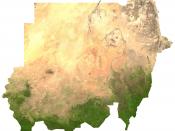The civil war and the drought have been main reason for famine in the Sudan.
The physical factor:
Long-term decline of rainfall in Southern Sudan.
Increased Rainfall Variability
Increase use of marginal land leading to degrading
Flooding
Social Factors
There is a high population, which is linked to use of marginal land due to erosion. Also there s high female illiteracy rate about 65%. The poor infant health has also caused the famine.
Agriculture factor, which led to famine
High variable per capita food production, long term the trend is static. Also low and falling fertilizes use led to famine. Another reason is lack of food surplus for the use in crisis.
Economic and Political factors:
There is high dependency on farming (70% of labor force, 37% of the GDP)
Also dependency on food imports whilst exporting non food goods. Also limited access to market to buy food / infrastructure has led to a famine in Sudan.
There is also a high military spending. These have caused less food availability and increase in prices.
The effects are 70,000 people have died due to hunger. Also this has led to organizations like UN making a World food programme. Also there has been economic deficiency. The programs aim to distribute seed packages for cereals, pulses, and oils according to local conditions
General Impacts:
Droughts endanger lives and livelihoods through thirst, hunger (due to crops dying from lack of water) and the spread of disease.
Millions of people died in the 20th century due to severe drought and famines. One of the worst hit areas was the Sahel region of Africa, which covers parts of Eritrea, Ethiopia and the Sudan.
Droughts and famines can have other geographical impacts. If drought forces people to migrate to a new home it could put...


